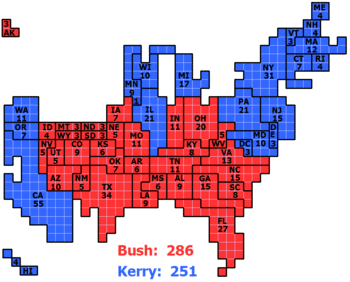From Wikipedia, the free encyclopedia
Electoral votes by state/federal district, for the elections of
2004 and
2008

Cartogram representation of the Electoral College for the 2004 election. Each square represents one electoral vote.
Electoral College map showing the results of the
2004 US Presidential Election. President
George W. Bush won the popular vote in 31 states (denoted in red) with 286 electoral votes. Senator
John Kerry of Massachusetts won the popular vote in 19 states and the District of Columbia (denoted in blue) and 251 electoral votes.
A Minnesota elector cast his Presidential and Vice Presidential votes for Democratic Vice Presidential candidate Senator
John Edwards of North Carolina. After the
2000 election it has become customary for states won by Democratic candidates to be colored blue and states won by Republican candidates
to be colored red on Electoral College maps.
The Electoral College consists of 538 popularly elected representatives who formally select the President and Vice President of the United States.[1] The Electoral College is an example of an indirect election.
Rather than directly voting for the President and Vice President, U.S. citizens cast votes for electors. Electors are technically
free to vote for anyone eligible to be President, but in practice pledge to vote for specific candidates[2] and voters cast ballots for favored Presidential and Vice Presidential candidates by voting for correspondingly pledged
electors.[3] Most states allow voters to choose between statewide slates of electors pledged to vote for the Presidential and Vice Presidential tickets of various parties; the ticket that receives the most votes statewide 'wins' all of the votes cast by electors from that
state. U.S. Presidential campaigns concentrate on winning the popular vote in a combination of states that choose a majority
of the electors, rather than campaigning to win the most votes nationally.
Each state has a number of electors equal to the number of its Senators and Representatives in the United States Congress. Additionally, the District of Columbia is given a number of electors equal to the number held by the smallest states.[4] U.S. territories are not represented in the Electoral College.
Each elector casts one vote for President and one vote for Vice President. In order to be elected, a candidate must have
a majority (at least 270) of the electoral votes cast for that office. Should no candidate for President win a majority of
the electoral votes, the choice is referred to the House of Representatives.[5] Should no candidate for Vice President possess a majority of the electoral votes, the choice is given to the Senate.[6]
The Constitution allows each state legislature to designate a method of choosing electors. Forty-eight states and the District of Columbia
have adopted a winner-take-all popular vote rule where voters choose between statewide slates of electors pledged to vote
for a specific Presidential and Vice Presidential candidate. The candidate that wins the most votes in the state wins the
support of all of that state’s electors. The two other states, Maine and Nebraska, use a tiered system where a single
elector is chosen within each Congressional district and two electors are chosen by statewide popular vote. U.S. Presidential
elections are effectively an amalgamation of 51 separate and simultaneous elections (50 states plus the District of Columbia),
rather than a single national election.
Candidates can fail to get the most votes in the nationwide popular vote in a Presidential election and still win that
election. This occurred in 1876, 1888 and 2000. Critics argue the Electoral College is inherently undemocratic and gives certain swing states disproportionate clout in selecting the President and Vice President. Adherents argue that the Electoral College is an important
and distinguishing feature of the federal system, and protects the rights of smaller states. Numerous constitutional amendments have been submitted seeking a replacement of the Electoral College with a direct popular vote. However, no submission has
ever successfully passed both Houses of Congress.

